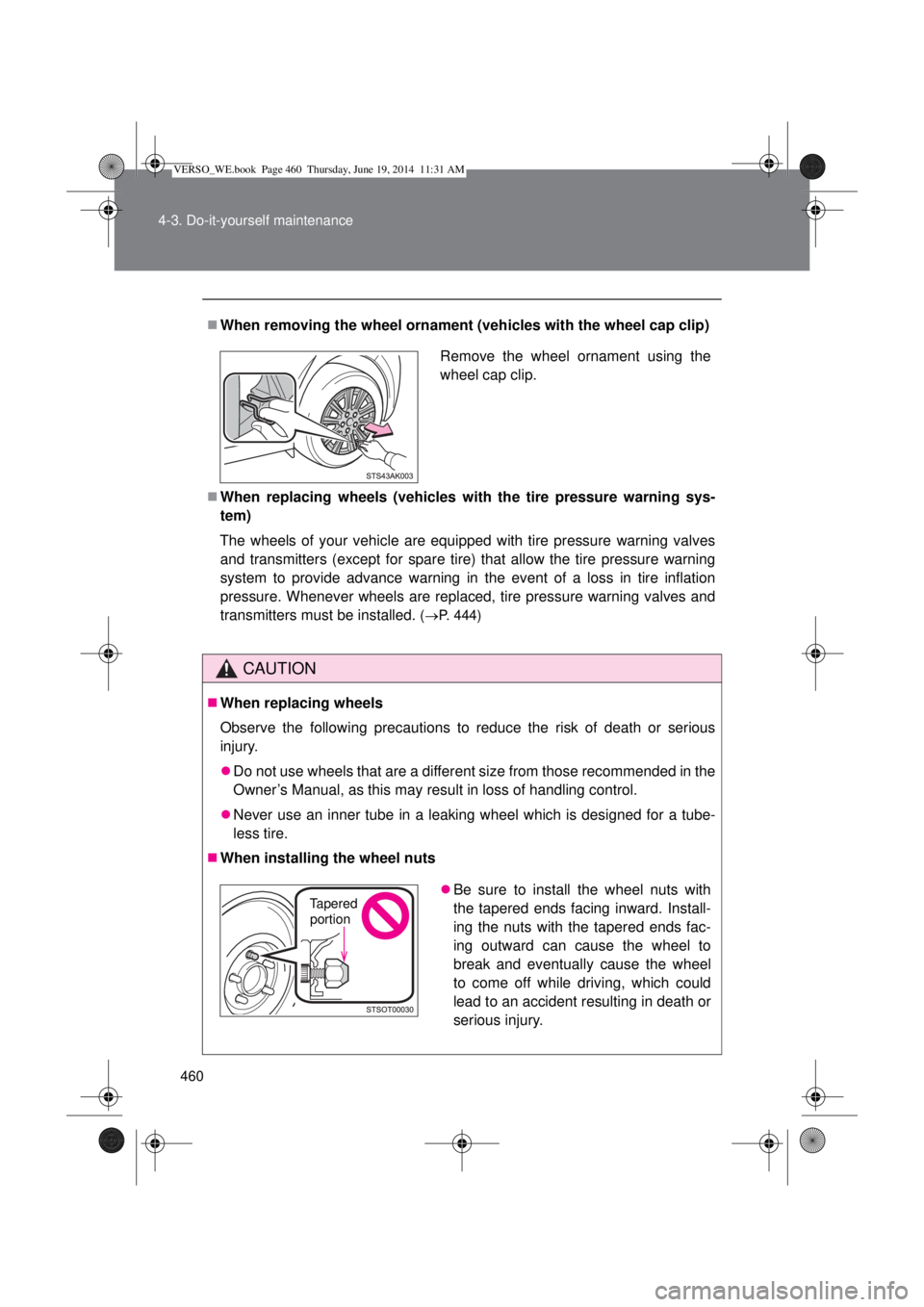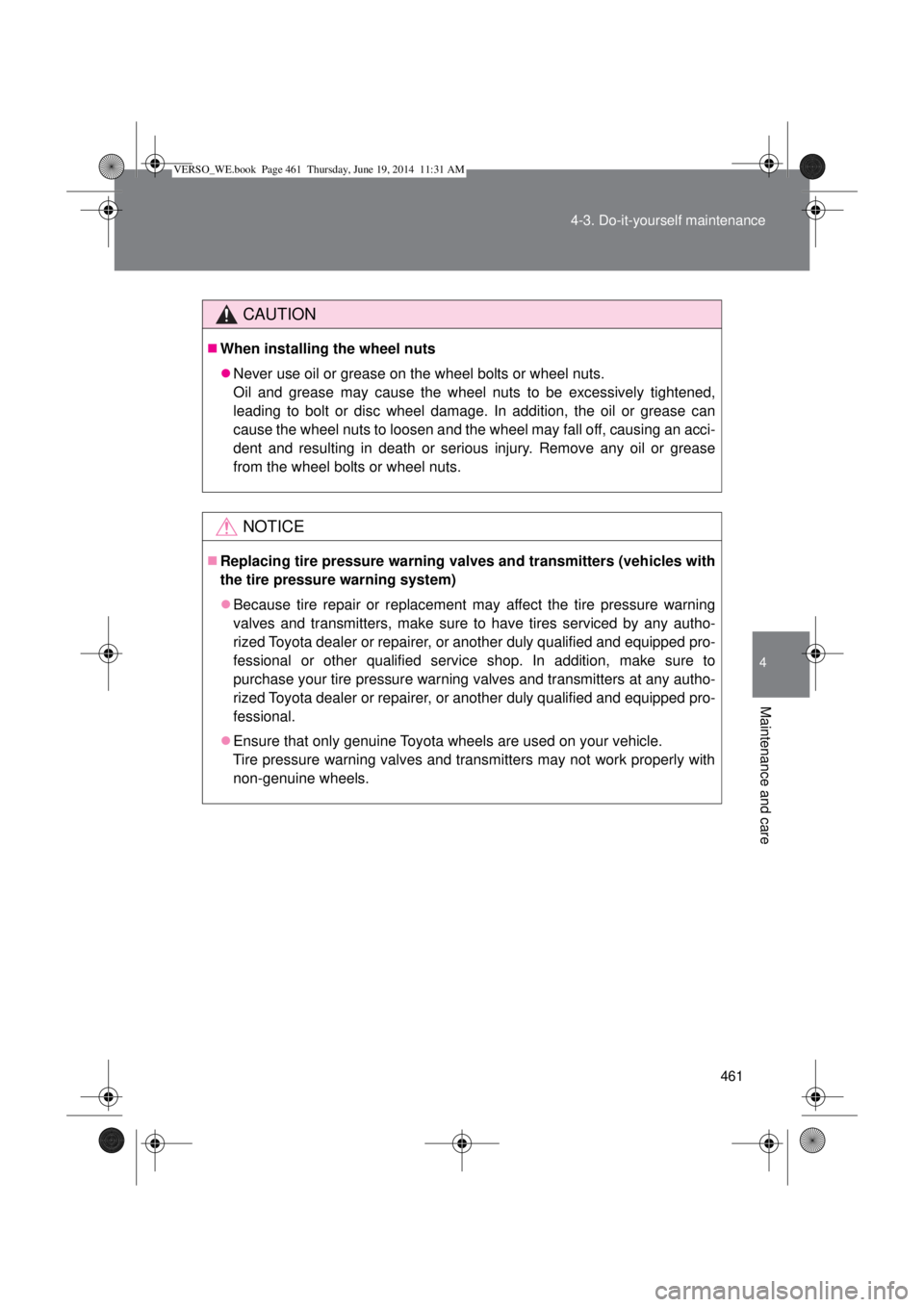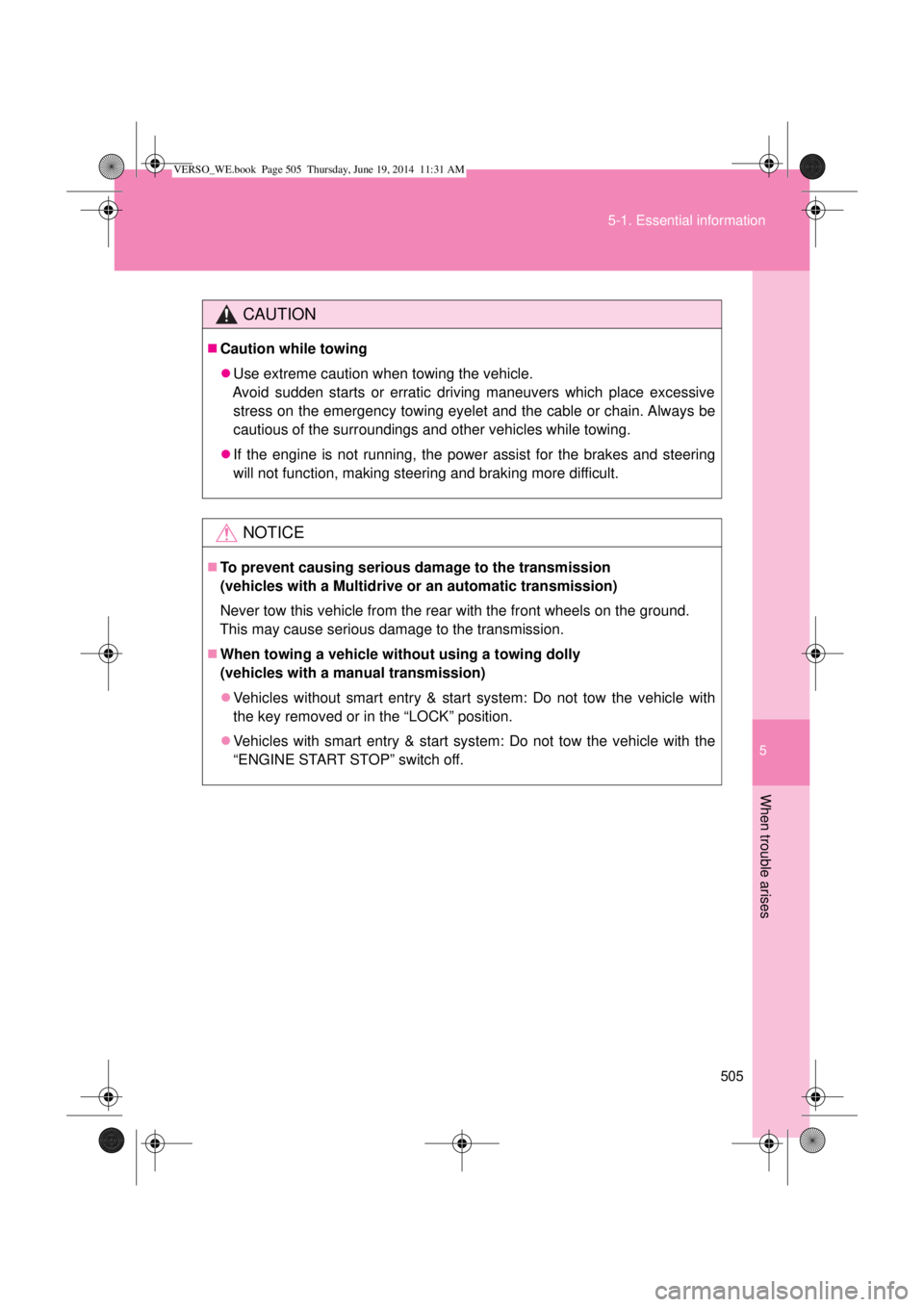Page 460 of 650

460 4-3. Do-it-yourself maintenance
When removing the wheel ornament (vehicles with the wheel cap clip)
When replacing wheels (vehicles with the tire pressure warning sys-
tem)
The wheels of your vehicle are equipped with tire pressure warning valves
and transmitters (except for spare tire) that allow the tire pressure warning
system to provide advance warning in the event of a loss in tire inflation
pressure. Whenever wheels are replaced, tire pressure warning valves and
transmitters must be installed.
(P. 444)
CAUTION
When replacing wheels
Observe the following precautions to reduce the risk of death or serious
injury.
Do not use wheels that are a different size from those recommended in the
Owner’s Manual, as this may result in loss of handling control.
Never use an inner tube in a leaking wheel which is designed for a tube-
less tire.
When installing the wheel nuts
Remove the wheel ornament using the
wheel cap clip.
Be sure to install the wheel nuts with
the tapered ends facing inward. Install-
ing the nuts with the tapered ends fac-
ing outward can cause the wheel to
break and eventually cause the wheel
to come off while driving, which could
lead to an accident resulting in death or
serious injury.Tapered
portion
VERSO_WE.book Page 460 Thursday, June 19, 2014 11:31 AM
Page 461 of 650

461 4-3. Do-it-yourself maintenance
4
Maintenance and care
CAUTION
When installing the wheel nuts
Never use oil or grease on the wheel bolts or wheel nuts.
Oil and grease may cause the wheel nuts to be excessively tightened,
leading to bolt or disc wheel damage. In addition, the oil or grease can
cause the wheel nuts to loosen and the wheel may fall off, causing an acci-
dent and resulting in death or serious injury. Remove any oil or grease
from the wheel bolts or wheel nuts.
NOTICE
Replacing tire pressure warning valves and transmitters (vehicles with
the tire pressure warning system)
Because tire repair or replacement may affect the tire pressure warning
valves and transmitters, make sure to have tires serviced by any autho-
rized Toyota dealer or repairer, or another duly qualified and equipped pro-
fessional or other qualified service shop. In addition, make sure to
purchase your tire pressure warning valves and transmitters at any autho-
rized Toyota dealer or repairer, or another duly qualified and equipped pro-
fessional.
Ensure that only genuine Toyota wheels are used on your vehicle.
Tire pressure warning valves and transmitters may not work properly with
non-genuine wheels.
VERSO_WE.book Page 461 Thursday, June 19, 2014 11:31 AM
Page 503 of 650
5
503
5-1. Essential information
When trouble arises
If your vehicle needs to be towed
Before towing
The following may indicate a problem with your transmission. Contact
any authorized Toyota dealer or repairer, or another duly qualified
and equipped professional, before towing.
The engine is running, but the vehicle will not move.
The vehicle makes an abnormal sound.
If towing is necessary, we recommend having your vehicle towed by
any authorized Toyota dealer or repairer, or another duly qualified
and equipped professional, such as or a commercial towing service,
using a lift-type truck or a flat bed truck.
Use a safety chain system for all towing, and abide by all state/pro-
vincial and local laws.
If towing from the front, the vehicle’s rear wheels and axles must be
in good condition. (P. 508)
If they are damaged, use a towing dolly or flat bed truck.
VERSO_WE.book Page 503 Thursday, June 19, 2014 11:31 AM
Page 504 of 650
504 5-1. Essential information
Emergency towing
If a tow truck is not available in an emergency, your vehicle may be
temporarily towed using a cable or chain secured to the emergency
towing eyelet. This should only be attempted on hard, surfaced roads
for short distances at low speeds.
A driver must be in the vehicle to steer and operate the brakes. The
vehicle’s wheels, drive train, axles, steering and brakes must be in
good condition.
Towing eyelet
Emergency towing procedure
Vehicles without smart entry & start system
Release the parking brake.
Put the shift lever in “N”.
Turn the engine switch in the “ACC” (engine off) or “ON” position
(engine running).
Vehicles with smart entry & start system
Release the parking brake.
Pull the shift lever in “N”.
The “ENGINE START STOP” switch must be in ACCESSORY
mode (engine off) or IGNITION ON mode (engine running).
VERSO_WE.book Page 504 Thursday, June 19, 2014 11:31 AM
Page 505 of 650

5
505 5-1. Essential information
When trouble arises
CAUTION
Caution while towing
Use extreme caution when towing the vehicle.
Avoid sudden starts or erratic driving maneuvers which place excessive
stress on the emergency towing eyelet and the cable or chain. Always be
cautious of the surroundings and other vehicles while towing.
If the engine is not running, the power assist for the brakes and steering
will not function, making steering and braking more difficult.
NOTICE
To prevent causing serious damage to the transmission
(vehicles with a Multidrive or an automatic transmission)
Never tow this vehicle from the rear with the front wheels on the ground.
This may cause serious damage to the transmission.
When towing a vehicle without using a towing dolly
(vehicles with a manual transmission)
Vehicles without smart entry & start system: Do not tow the vehicle with
the key removed or in the “LOCK” position.
Vehicles with smart entry & start system: Do not tow the vehicle with the
“ENGINE START STOP” switch off.
VERSO_WE.book Page 505 Thursday, June 19, 2014 11:31 AM
Page 506 of 650
506 5-1. Essential information
Installing towing eyelet
Remove the eyelet cover using a
flathead screwdriver.
To protect the bodywork, place a
rag between the screwdriver and
the vehicle body, as shown in the
illustration.
Insert the towing eyelet into the
hole and tighten partially by
hand.
Tighten down the towing eyelet
securely using a wheel nut
wrench
* or hard metal bar.
*: If a wheel nut wrench is not
equipped, a wheel nut wrench
can be purchased at any autho-
rized Toyota dealer or repairer, or
another duly qualified and
equipped professional.
Location of the emergency towing eyelet
P. 536, 552
VERSO_WE.book Page 506 Thursday, June 19, 2014 11:31 AM
Page 508 of 650
508 5-1. Essential information
Towing with a wheel-lift type truck from the front
Release the parking brake.
NOTICE
To prevent damaging the vehicle
When raising the vehicle, ensure adequate ground clearance for towing at
the opposite end of the raised vehicle. Without adequate clearance, the
vehicle could be damaged while being towed.
VERSO_WE.book Page 508 Thursday, June 19, 2014 11:31 AM
Page 509 of 650
5
509 5-1. Essential information
When trouble arises
Towing with a wheel-lift type truck from the rear
Vehicles with a Multidrive or an
automatic transmission: Use a
towing dolly under the front
wheels.
Vehicles with a manual transmis-
sion: We recommend to use a
towing dolly under the front
wheels.
Vehicles without smart entry &
start system: When not using a
towing dolly, turn the engine
switch to the “ACC” position and
shift the shift lever to “N”.
Vehicles with smart entry & start
system: When not using a towing
dolly, turn the “ENGINE START
STOP” switch to ACCESSORY
mode and shift the shift lever to
“N”.
VERSO_WE.book Page 509 Thursday, June 19, 2014 11:31 AM